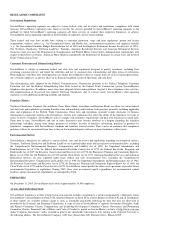American Home Shield 2006 Annual Report Download - page 20
Download and view the complete annual report
Please find page 20 of the 2006 American Home Shield annual report below. You can navigate through the pages in the report by either clicking on the pages listed below, or by using the keyword search tool below to find specific information within the annual report.
Operating income for 2005 increased five percent to $340 million, compared with $324 million in 2004. The increase in operating
income primarily reflects solid profit growth at Terminix supported by improved labor and material cost efficiencies, improved
profitability in the TruGreen LandCare operations, and reduced safety-related costs throughout the enterprise. These factors were
offset in part by higher fuel costs, increased claim costs at American Home Shield due to hotter weather conditions, a $10 million
unfavorable adjustment recorded by Terminix to correct the estimation of prior year damage claim reserves, a $4 million gain that
TruGreen ChemLawn realized in the third quarter of 2004 from the sale of a support facility, as well as the first time inclusion of
approximately $3 million of seasonal operating losses in the Canadian operations acquired by TruGreen ChemLawn in April 2004.
As previously disclosed, the Company has experienced both positive and negative trending in some of its key factor costs. The
Company's large fleet continues to be negatively impacted by significant increases in oil prices, which have also adversely impacted
fertilizer costs at TruGreen ChemLawn. Although the Company hedges approximately two-thirds of its estimated annual fuel usage,
even net of the hedges, fuel costs of continuing operations increased approximately $13 million in 2005. Oil prices remain high, and
the Company currently estimates that its continuing operations will absorb approximately $.02 per share of incremental fuel costs in
2006. As previously discussed, GPS and routing and scheduling technologies that the Company has been implementing will tighten
routes and reduce drive time and fuel consumption. Health care costs continue to experience strong inflationary pressures, and this
is expected to continue. The Company will also be making an additional investment in employee health care benefits of
approximately $.01 per share in 2006, as part of its efforts to further enhance its position as an employer of choice.
On the positive side, the Company continues to experience very favorable results from its efforts to reduce safety-related costs,
which include workers compensation, auto and general liability claims. In 2005, the Company achieved a four percent reduction in
vehicle collisions and a double digit decline in lost employee work day cases. Total costs from continuing operations, including the
income statement effects of favorable trending of prior year claims, were down almost $10 million for the year. The Company has
set a goal of $12 to $15 million of additional savings from continuing operations over the next two to three years.
Tax Agreement
In January 2005, the Company reached a comprehensive agreement with the Internal Revenue Service (IRS) regarding its
examination of the Company's federal income taxes through the year 2002. As a result of this agreement, the Company recorded in
its 2004 financial statements certain deferred tax assets which had previously not been recorded due to uncertainties associated with
the complexity of the matters under review and the extended period of time effectively covered by the examination. This resulted in
a non-cash reduction in the Company's 2004 income tax provision, thereby increasing 2004 consolidated net income by
approximately $159 million ($150 million, or $.49 per diluted share, related to continuing operations and $9 million, or $.03 per
diluted share, related to businesses held pending sale and discontinued operations). Related to the IRS agreement, the Company
realized tax savings of $25 million in 2004, made tax payments in early 2005 totaling $131 million and realized a $45 million
reduction in estimated tax payments in the third and fourth quarters of 2005. Additionally, this agreement resulted in a deferred tax
annuity totaling $57 million that will be realized through 2016.
Operating and Non-Operating Expenses
Cost of services rendered and products sold increased five percent compared to the prior year and decreased as a percentage of
revenue to 62.1 percent in 2005 from 62.6 percent in 2004. This decrease reflects improved labor and materials management at
TruGreen LandCare and improvements in safety-related costs throughout the enterprise. Selling and administrative expenses
increased eight percent and increased as a percentage of revenue to 27.2 percent from 26.7 percent in 2004. The increase in selling
and administrative expenses primarily reflects investments to increase market penetration and improve customer retention and other
strategic initiatives.
Net interest expense decreased $8 million from 2004, primarily reflecting lower interest expense resulting from the repayment of
fixed rate debt in April 2005, as well as higher investment income experienced on the American Home Shield investment portfolio.
It is important to note that investment returns are an integral part of the business model at American Home Shield, and there will
always be some market-based variability in the timing and amount of investment returns realized from year to year.
The effective tax rate for continuing operations was a 39 percent tax expense in 2005 and a 17 percent tax benefit in 2004. The
comparison of the effective tax rate is impacted by the Company's agreement with the IRS which resulted in a $150 million non-
cash reduction in the 2004 income tax provision for continuing operations. The Company expects that its effective tax rate for 2006
will approximate 39 percent.
Segment Review (2005 vs 2004)
The segment reviews should be read in conjunction with the required footnote disclosures presented in the Notes to the
Consolidated Financial Statements. This disclosure provides a reconciliation of segment operating income to income from
continuing operations before income taxes, with net non-operating expenses as the only reconciling item. The Company's segment
reviews include discussions of capital employed, which is a non-U.S. GAAP measure that is defined as the segment's total assets
less liabilities, exclusive of debt balances. The Company believes this information is useful to investors in helping them compute
return on capital measures and therefore better understand the performance of the Company's segments. The Notes to the
Consolidated Financial Statements also include a reconciliation of segment capital employed to its most comparable U.S. GAAP
measure.
12
























